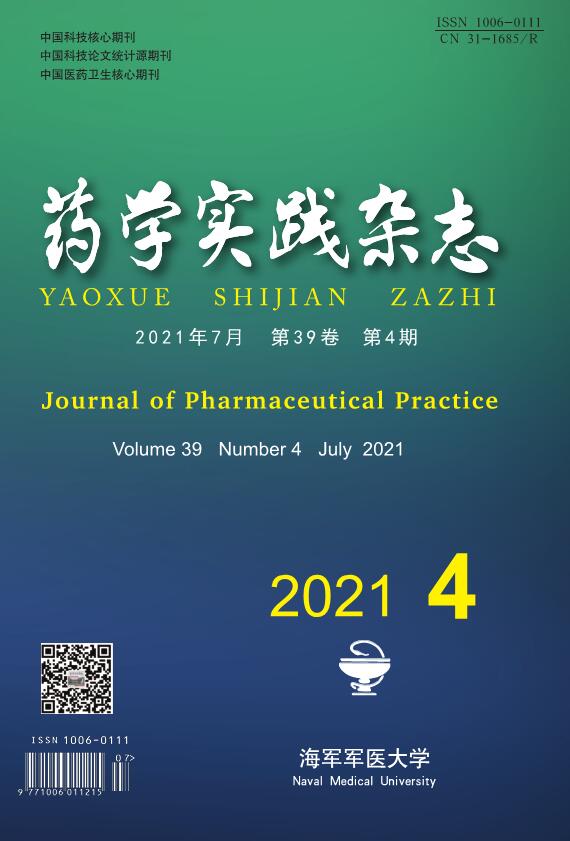-
膝骨关节炎多发于老年患者,目前认为其发病机制在于患者膝关节软骨过度磨损、膝关节间隙骨质增生及膝关节间隙变窄等,可引起患者严重的关节功能障碍,随着我国逐渐进入老龄化社会,膝骨关节炎的临床发病率逐年增加[1-2]。全膝关节置换术被誉为21世纪医学领域三大贡献之一,是老年膝骨关节炎的最佳治疗手段,但术中患者失血量较多,术后隐性失血量较大,容易对患者术后恢复造成严重影响,尤其是对于机体功能恢复较差的老年患者,可引起患者深静脉血栓、肺栓塞等较为严重的术后并发症[3]。氨甲环酸是赖氨酸的衍生物,具有良好的抗纤溶效果,近年研究报道[4]显示,其具有较好的止血效果,但目前其应用于老年全膝关节置换术的止血机制尚未完全明确。基于此,本研究在全膝关节置换围手术期使用氨甲环酸,效果显著,现报道如下。
HTML
-
以2018年12月至2020年3月定州市人民医院关节外科收治的老年膝骨关节炎患者120例为研究对象,采用随机数字表法分为对照组和观察组,各60例。对照组男30例,女30例;年龄57~68岁,平均(63.27±2.31)岁;全膝关节左侧置换28例,全膝关节右侧置换32例;术前Kllgren-Lawrence分级[5]Ⅱ级35例,Ⅲ级25例。观察组男34例,女26例;年龄57~68岁,平均(63.33±2.17)岁;左侧置换26例、右侧置换34例;术前Kllgren-Lawrence分级Ⅱ级37例,Ⅲ级23例。两组性别、年龄、左侧或右侧置换等一般资料均无统计学差异(P>0.05),具有可比性。本研究获本院医学伦理委员会审核批准。
-
纳入标准:①符合《骨关节炎诊治指南(2007年版)》[6]中膝骨关节炎相关诊断标准者;②术前Kllgren-Lawrence分级为Ⅱ~Ⅲ级者;③术前无凝血功能异常且未使用抗凝血药物者;④无精神障碍、语言障碍、听力障碍者;⑤临床资料完整,对本研究知情同意者等。排除标准:①有膝关节手术史者;②合并骨髓炎、骨质疏松等骨关节疾病者;③合并严重脏器功能异常、严重感染性疾病者;④双侧膝关节功能病变者等。
-
对照组采用全膝关节置换术进行治疗,患侧股神经阻滞联合全身麻醉后,经髌旁内侧入路,暴露膝关节腔,去除骨赘,切除前后十字韧带及内外侧半月板;股骨截骨采用髓内定位,胫骨截骨采用髓外定位,依据假体类型选择不同的后倾角度,内外侧软组织及后方关节囊松解,注意平衡屈伸间隙及内、外侧关节稳定性;采用后十字韧带替代型骨水泥固定人工膝关节假体(PFC-Sigma,国械注进20173460169,美国默克公司,材料代号:铸造钴铬钼合金);手术在止血带下完成,压力设定为收缩压150 mmHg,缝合切口并使用弹力绷带加压包扎后松止血带。术后于关节腔内放置引流管1根,术后12 h后拔除,术前术后常规预防感染,术后12 h开始使用肝素(深圳赛保尔生物药业有限公司,国药准字H20060190,1.0 ml:2 000 U)2 000 U,1次/d,抗凝至术后12 d。
观察组在对照组的基础上联合氨甲环酸注射液(江苏朗欧药业有限公司,国药准字H32022144,5 ml:0.5 g)进行治疗,于使用止血带前静脉滴注10 ml氨甲环酸溶液,手术完成后通过引流管向关节腔内注射40 ml氨甲环酸溶液。两组术后均随访6个月。
-
统计两组术中失血量、隐性失血量、术后引流量、术后引流时间、创面干燥时间、创面愈合时间等。
-
术前和术后48 h,抽取患者静脉血5 ml,采用Thermo Scientific HAAKE型血液流变仪(赛默飞世尔科技公司,型号:RheoStress6000)检测两组凝血酶原时间(PT)、部分凝血活酶时间(APTT)、全血纤维蛋白原(FIB)水平。
-
采用美国特种外科医院提出的膝关节评分系统(HSS)[7],分别在术前和术后6个月对所有入选患者膝关节功能进行评价,包括疼痛程度(25分)、行走稳定情况(15分)、行走距离(15分)、行走辅助(15分)、伸屈情况(15分)、肌力水平(15分),总分100分,计算患者评价得分,总分越低说明患者膝关节功能越差。
-
记录两组住院期间术后切口血肿、切口感染、下肢深静脉血栓等并发症发生情况。
-
数据分析使用SPSS 21.0统计软件进行。计量资料使用(
$\;\bar x \pm s$ )来表示,组内比较和组间比较分别使用配对t检验和独立样本t检验。计数资料使用[n(%)]表示,卡方检验进行比较。以P<0.05表示差异具有统计学意义。
1.1. 一般资料
1.2. 纳入及排除标准
1.3. 治疗方法
1.4. 观察指标
1.4.1. 手术相关指标
1.4.2. 凝血功能
1.4.3. 膝关节功能
1.4.4. 并发症
1.5. 统计学方法
-
观察组患者术中失血量、隐性失血量、术后引流量均低于对照组(P<0.05),且术后引流时间、创面干燥时间、创面愈合时间均短于对照组(P<0.05),见表1。
组别 n 术中失血量(V/ml) 隐性失血量(V/ml) 术后引流量(V/ml) 术后引流时间(t/d) 创面干燥时间(t/d) 创面愈合时间(t/d) 对照组 60 188.38±21.75 600.36±60.37 310.43±47.38 5.62±1.03 2.86±0.55 16.35±2.35 观察组 60 173.27±19.05 417.43±53.28 250.36±39.28 3.26±0.26 2.01±0.41 14.26±2.71 t值 − 4.048 17.598 7.560 17.208 9.598 4.513 P − <0.001 <0.001 <0.001 <0.001 <0.001 <0.001 -
与术前比较,术后48 h两组APTT、PT、FIB差异无统计学意义(P>0.05),组间比较,差异无统计学意义(P>0.05),见表2。
凝血功能指标 对照组(n=60) 观察组(n=60) 术前 术后48 h 术前 术后48 h APTT(t/s) 39.61±4.19 38.19±3.48 39.27±3.95 38.47±3.52 PT(t/s) 15.66±2.44 15.45±2.67 15.62±2.37 15.43±2.75 FIB(g/L) 3.96±0.27 3.69±0.29 3.98±0.36 3.74±0.32 -
术前两组患者疼痛情况、行走稳定情况、行走距离、行走辅助、伸屈情况、肌力水平无统计学差异(P>0.05),术后6月观察组患者疼痛情况、行走稳定情况、行走距离、行走辅助、伸屈情况、肌力水平均显著优于对照组,差异有统计学意义(P<0.05),见表3。
膝关节功能指标 对照组(n=60) 观察组(n=60) 术前 术后6月 术前 术后6月 疼痛程度 13.49±4.33 17.85±4.22* 13.42±4.23 21.03±3.26* 行走稳定情况 3.48±1.28 5.63±1.19* 3.44±1.22 7.84±2.03* 行走距离 3.25±1.33 6.49±2.33* 3.27±1.31 8.86±2.45* 行走辅助 4.49±1.24 7.16±2.02* 4.52±1.20 9.12±2.15* 伸屈状况 7.20±1.75 10.69±2.42* 7.16±1.86 13.15±1.04* 肌力水平 2.76±1.03 6.77±1.46* 2.74±0.92 8.84±1.93* *P<0.05,与术前比较。 -
治疗期间,观察组并发症总发生率为8.33%,对照组并发症总发生率为13.33%,组间比较,差异无统计学意义(P>0.05),见表4。
组别 n 术后切口
血肿切口感染 下肢深
静脉血栓其他 并发症
总发生率对照组 60 2(3.33) 2(3.33) 0(0.00) 4(6.67) 8(13.33) 观察组 60 1(1.67) 0(0.00) 1(1.67) 3(5.00) 5(8.33)
2.1. 两组手术相关指标比较
2.2. 两组手术前后凝血功能比较
2.3. 两组手术前后膝关节功能比较
2.4. 两组并发症比较
-
膝关节是人体结构较为复杂、承受杠杆作用力最强的关节,主要负责下肢屈伸运动,兼具旋转运动,其组成主要包括胫骨关节及髌骨关节,膝骨关节炎病情发展缓慢,但最终会破坏整个关节组织,对患者关节功能造成损伤,导致关节功能障碍,影响患者生活质量[8-9]。随着医疗科技的飞速发展,人工假体的改进以及技术的成熟,全膝关节置换术是治疗膝骨关节炎最重要的方法之一,其可明显降低患者膝关节疼痛,改善患者关节功能,提高患者生活质量[10],但由于膝关节特殊的生理结构,使得患者术中出血较多,不利于患者术后的恢复,如何减少患者术中失血和隐性失血已经成为临床亟待解决的问题。术中使用止血带是目前临床外科手术中最常用的止血方法,但松开止血带后会刺激纤维蛋白溶解,导致术后出血增加,同时使用止血带可加重患者术后疼痛程度[11]。
本研究结果显示,观察组患者术中失血量、隐性失血量、术后引流量均低于对照组,且术后引流时间、创面干燥时间、创面愈合时间均短于对照组,而术后48 h两组凝血功能比较,差异无统计学意义,住院期间两组并发症发生情况差异无统计学意义,说明在全膝关节置换术中和术后使用氨甲环酸可有效减少老年膝骨关节炎患者术中和术后出血,促进创面愈合,且不会影响患者凝血功能,同时术后并发症少,安全性好。分析原因在于,氨甲环酸具有与赖氨酸相似的化学结构,可通过竞争性抑制纤溶酶或纤溶酶原与纤维蛋白赖氨酸残基的结合,进而抑制纤溶酶原激活或纤溶酶的功能,抑制机体溶血,进而达到止血的效果,有效减少术中和术后出血,此外本研究结果显示与两组患者术前及术后APTT、PT、FIB差异无统计学意义,术后并发症总发生率亦无统计学意义,这充分说明静脉滴注、关节腔局部应用氨甲环酸充分发挥止血效果的同时,并不影响患者凝血功能,安全性较高,术后并发症也较少[12-13]。此外,氨甲环酸可通过减少术后出血和血液的渗出,抑制患者皮下血肿的形成,使局部组织张力降低,促进皮瓣及局部组织早期粘连,减少创面感染的风险,促进创面快速愈合[14]。
术后出血导致的肢体肿胀可影响患者术后创面愈合,增加感染的风险,进而影响患者膝关节功能恢复。本研究结果显示,术后6个月,观察组患者疼痛情况、行走稳定情况、行走距离、行走辅助、伸屈情况、肌力水平得分均高于对照组,说明氨甲环酸可有效促进老年膝骨关节炎患者术后膝关节功能的恢复。氨甲环酸可通过抗纤溶作用减少患者术中和术后出血,一方面减少术中失血可促进患者术后恢复,另一方面,减少术后失血可有效降低感染、切口周围血肿等并发症的发生,促进患者创面愈合,尽快进入术后康复阶段,进而有效促进患者术后膝关节功能的恢复[15]。
综上所述,氨甲环酸可有效减少老年膝骨关节炎患者全膝关节置换术中失血,降低术后引流量,缩短术后引流时间,促进创面愈合,同时改善患者膝关节功能,且对凝血功能影响小,术后并发症少。










 DownLoad:
DownLoad: